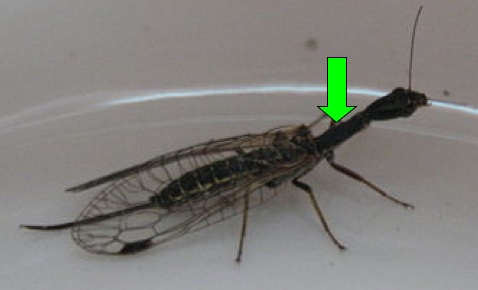
 |
| Home | Who We Are | List of Orders | References | Contact Us |
Insect Identification Key Based on your answers to the questions, you have identified your insect as being in the order Raphidioptera! Members of this order include:
snakeflies. Etymology:
Raphidioptera comes from the Greek raphio, which means needle, and ptera, which means wings. &ldquoNeedle” refers to the very long ovipositor (of egg-laying structure) present in females. The ovipositor extends like a long, thin spear or needle from the tip of the female’s abdomen. General characteristics: Number of species worldwide:
about 260 Basic ecology: Classification:
For a list of all of the orders in this key, click here: List of Orders. Classification note:
Snakeflies are not flies. True flies are in the order Diptera. Oops! If this doesn't appear to be the order for your insect, go back through the key and look more carefully at your insect while answering the questions again. Your perseverance will reward you! I would like to return to the start of this key. Unless noted otherwise, photographs on this website are the property of the photographers and may not be reused without written permission from the photographers. To obtain permission, request it here. Photos at the top of this website are by: Leslie Mertz, Ph.D., LMERTZ@nasw.org. Reproduction of material from any KnowYourInsects.org webpages without written permission is strictly prohibited.
Order Raphidioptera: the snakeflies

Click here to see more examples of more snakeflies!
• two pairs of membranous wings that are similar in size and shape
• the presence of a colored stigma in its forewings (see the photo) — depending on the species, the stigma may be numerous colors ranging from a pale to dark
• a long prothorax, which gives the insect long-“necked” appearance
• long, thin antennae
• females possess a long egg-laying structure, called an ovipositor, that extends like a thin spear from the rear of the abdomen
• large compound eyes, one located on each side of a the head
• somewhat flattened head with chewing mouthparts
• long, slender body
• wings are held roof-like over the body when the insect is at rest
• holometabolous metamorphosis (egg — larva — pupa — adult)
Click here to see more examples of more snakeflies!

Snakeflies live in forested areas as well as alpine regions with few trees or shrubs. Their distribution is patchy and some species are known from only very small areas. Snakeflies are known only from the Northern Hemisphere. While some live in western North American, no species are yet known east of the Rocky Mountains. Females use their long ovipositors to lay eggs in the bark of trees. The eggs hatch into larvae in a few days to three weeks, and the larvae continue to live under the bark for one to three years until they pupate. Most adults emerge from the pupae in a few days to three weeks, but in some species, pupation may take as much as 10 months. As adults, snakeflies feed on other insects, especially aphids and other members of the suborder Sternorrhyncha.
Kingdom Animalia
Phylum Arthropoda
Class Insecta
Order Raphidioptera
Home Who We Are
List of Orders
References
Contact Us